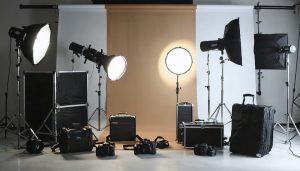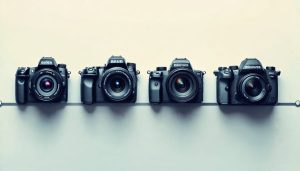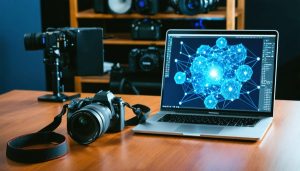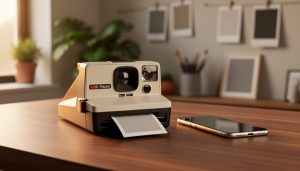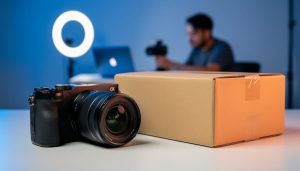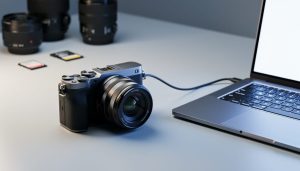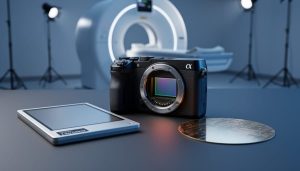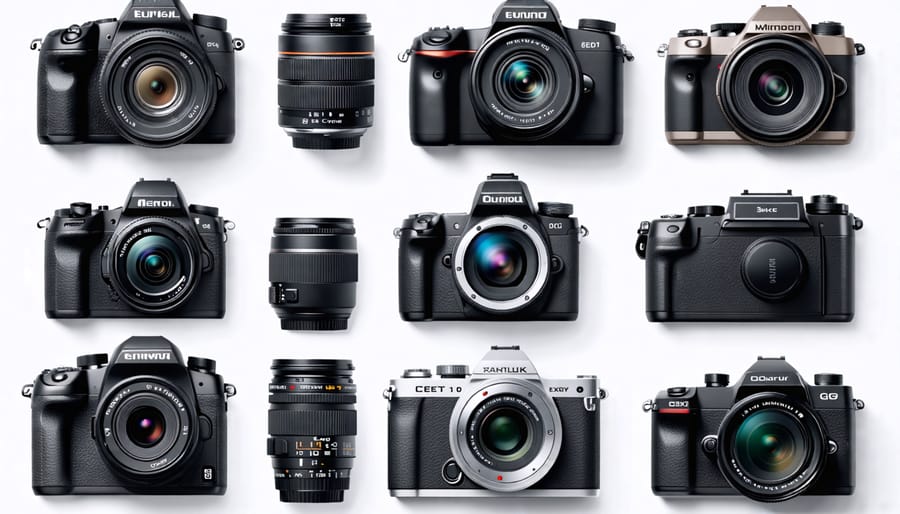
Determine your primary use: Decide if your camera is for casual photography, professional shoots, or hybrid video work. Your purpose guides your choice significantly. Compare models across categories such as compact, mirrorless, and DSLR to identify what aligns with your needs. Explore sensor sizes and how they impact image quality, especially in diverse lighting conditions. Balance essential features and budget; prioritize functions like autofocus speed, lens compatibility, and ergonomics for a rewarding photography experience. For more personalized decisions on buying the perfect camera, consider real-world use cases and expert recommendations tailored to your unique requirements.
Understanding Digital Camera Types
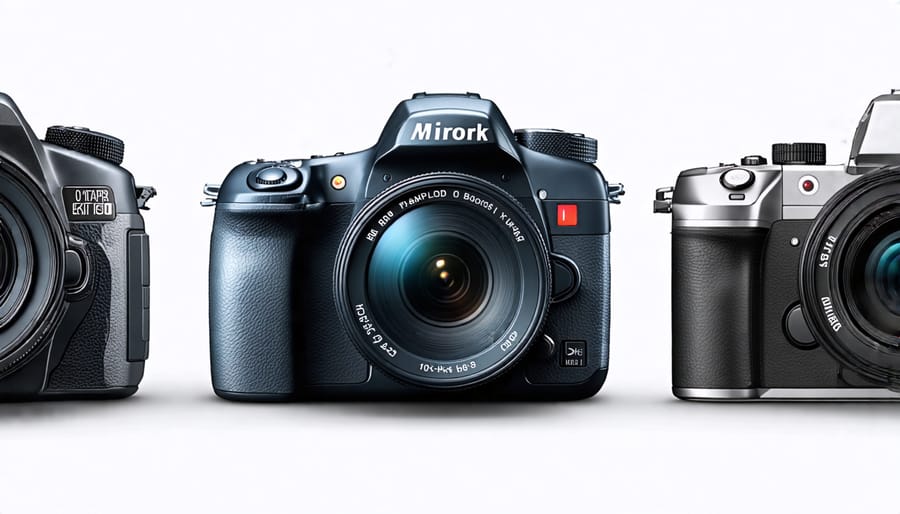
DSLR Cameras
DSLR cameras, or digital single-lens reflex cameras, are a popular choice among enthusiasts and professional photographers, offering a powerful blend of versatility and control. One of their standout features is the ability to interchange lenses, allowing photographers to tailor their equipment to any situation—be it capturing the delicate blush of a sunset with a wide-angle lens or focusing on intricate details with a macro lens. This flexibility is complemented by a wide range of manual settings, giving photographers the freedom to experiment with exposure, aperture, and shutter speed to craft each shot to their precise vision.
In practice, DSLRs often provide fast autofocus and exceptional image quality, even in challenging lighting conditions, thanks to their larger sensors. These cameras are also designed to be robust and ergonomic, making them a reliable companion for those lengthy shoots or adventurous outings. For photographers who cherish the tactile experience of photography—where every adjustment feels intuitive and every click a step towards the perfect shot—DSLRs offer a unique hands-on experience. Whether you’re capturing professional portraits or indulging in weekend photography adventures, DSLRs prove to be a reliable and rewarding choice.
Mirrorless Cameras
Mirrorless cameras have quickly become a favorite among photographers due to their advanced technology, shining through in image quality and versatile functionalities. Unlike traditional DSLRs, mirrorless cameras operate without a mirror mechanism, allowing for a more compact and lightweight build. This portability makes them an ideal choice for photographers on the go, whether you’re hiking through a landscape or capturing the streets of a bustling city. Enthusiasts and professionals alike appreciate the diverse range of lenses available, catering to everything from macro photography to wide-open vistas. The electronic viewfinder and fast autofocus systems provide an edge in dynamic shooting scenarios, making them excellent for both action shots and portrait sessions. For those looking to explore this category further, the best mirrorless cameras offer a range of options tailored to various needs and budgets. Their adaptability continues to inspire creative exploration, offering a bridge between cutting-edge technology and the art of photography.
Compact Cameras
Compact cameras are perfect for beginners and casual photographers thanks to their simplicity and cost-effectiveness. These cameras offer intuitive controls, making them easy to use without a steep learning curve. You’ll find that their lightweight and portable design means you can capture moments on the go, without the bulk of professional gear. Compared to more advanced cameras, compact models are budget-friendly, allowing you to explore photography without breaking the bank. Moreover, they often come with built-in features like automatic modes and optical zoom, helping you take quality photos right out of the box. For anyone just starting, compact cameras provide an excellent balance of ease and capability.
Key Features to Consider
Sensor Size and Resolution
When it comes to digital photography, understanding sensor size and resolution is crucial for capturing high-quality images. Think of the sensor as the camera’s “canvas.” A larger sensor usually captures more light and detail, which can lead to better image quality, especially in low-light conditions. Full-frame sensors, for instance, tend to deliver superior dynamic range and depth of field, ideal for those dramatic landscape shots or detailed portraits. However, they make the camera bigger and more expensive—something to consider if you’re shooting on the go.
Resolution, measured in megapixels, indicates the amount of detail a camera can capture. While more megapixels can mean sharper prints, especially in large formats, they aren’t the only factor determining image quality. For many, a sensor that balances both size and resolution meets the needs for both daily shooting and special projects. Remember, a high-resolution camera with a small sensor might deliver pixel-packed images but could struggle with noise in challenging lighting. Balancing these elements based on your photography style and conditions is key to making an informed choice.
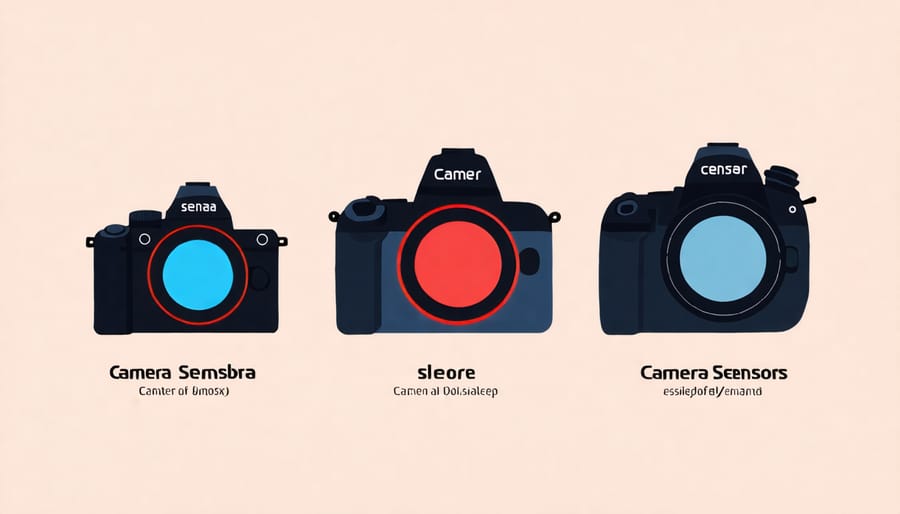
Lens Compatibility and Options
When exploring digital cameras, lens compatibility and options play a vital role in enhancing creative flexibility. Whether you’re a seasoned professional or an enthusiastic hobbyist, understanding your camera’s lens ecosystem is key. Different camera brands offer a variety of choices, designed to fulfill distinct photographic needs. For instance, Canon users can explore a wide range of options, as highlighted in our guide to the best lenses for Canon cameras.
Mirrorless cameras often boast the advantage of adapting older lenses from various brands, offering even more diversity. This adaptability can be a game-changer, allowing photographers to experiment with different styles and techniques without needing entirely new equipment. On the other hand, DSLR lenses might offer more traditional compatibility across different DSLR models, giving users access to an extensive collection of optics crafted over decades. When selecting lenses, consider what type of photography excites you—be it wide landscapes or detailed macro shots—and ensure your system supports the creative vision you aim to achieve. Exploring these lenses not only broadens your toolkit but also expands your photographic horizons.
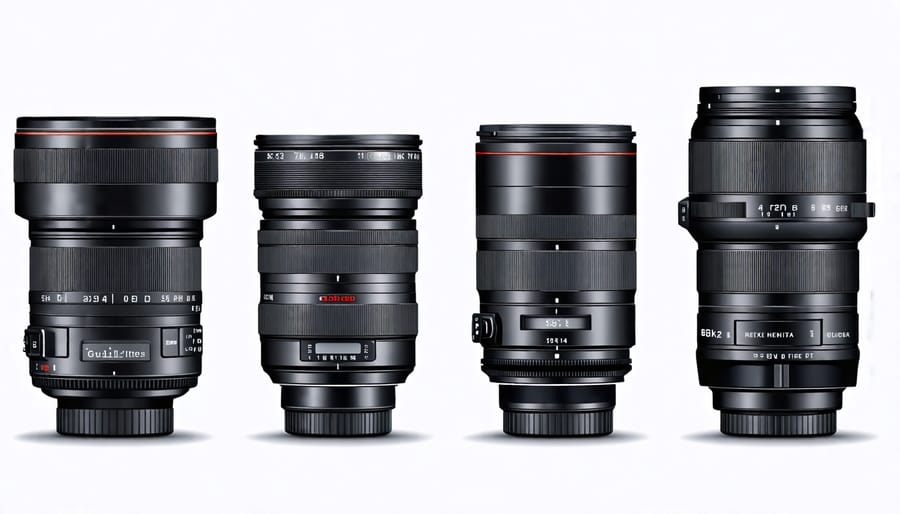
Autofocus Systems
Autofocus systems play a crucial role in photography, particularly when it comes to capturing fast-moving subjects like sports or wildlife. Two primary types of autofocus systems—contrast-detection and phase-detection—each offer unique advantages. Contrast-detection, often found in mirrorless cameras, excels in accuracy under low-light conditions, though it might struggle with speed. In contrast, phase-detection, commonly used in DSLR cameras, delivers rapid focus capabilities, making it ideal for action shots. Many modern cameras blend both systems, utilizing hybrid autofocus to optimize performance. For instance, capturing a sprinting child or a distant bird in flight becomes much easier with Canon’s Dual Pixel or Sony’s Eye AF systems, which smartly predict movement for razor-sharp images.
Image Stabilization and Low Light Performance
Capturing sharp, vivid images in low-light settings can be challenging, but modern digital cameras are equipped with advanced features to tackle this. Image stabilization technology is a game-changer, minimizing blur from shaky hands or moving subjects. You can usually choose between optical and in-body stabilization—both efficiently keeping your shots steady. For low-light scenarios, a camera’s sensor size and ISO performance are crucial. A larger sensor captures more light and detail, while expandable ISO settings allow for brighter photos without excessive noise. Imagine photographing a street scene at dusk or a dimly lit concert—these features ensure your images remain crisp and vibrant.
Setting a Budget: How Much Should You Spend?
When it comes to setting a budget for a digital camera, the key is focusing on your specific needs and long-term goals. Whether you’re an enthusiastic hobbyist or a seasoned professional, understanding what you need from a camera ensures you’re investing wisely.
First, evaluate your photography goals. Are you interested in landscape photography, snapping portraits, or capturing fast-paced action shots? If landscapes and portraits are your focus, investing in a camera with high resolution and good dynamic range could be a priority. For action shots, you might consider a model with faster shutter speeds and superior autofocus capabilities. Different photographic interests often dictate different budget considerations.
Next, assess your experience level and technical requirements. Beginners might find a mid-range mirrorless or DSLR camera sufficient, offering the perfect balance between quality and affordability. On the other hand, professionals or enthusiasts who demand more from their gear could justify spending more on high-end cameras with advanced features like weather sealing or dual memory card slots, which enhance durability and flexibility in demanding shooting conditions.
Consider not only the camera body but also the cost of lenses and accessories. A well-chosen lens can dramatically improve the versatility and quality of your shots. Thus, leaving some room in your budget for at least one or two quality lenses is crucial.
Moreover, think about the longevity of your investment. High-end models may have a steeper upfront cost, but they’re often more durable and offer greater room for growth over time, making them cost-effective in the long run. Conversely, starting with an entry-level model might be financially prudent if you’re just starting out and want to test the waters before making a more significant investment.
Lastly, factor in your budget constraints but allow for some flexibility. The rapidly evolving camera technology means that there’s always potential for getting a great deal on slightly older models, which still offer excellent performance. By cautiously balancing your current needs with your aspirations, you can make a smart financial decision that delivers creative satisfaction every time you click the shutter.
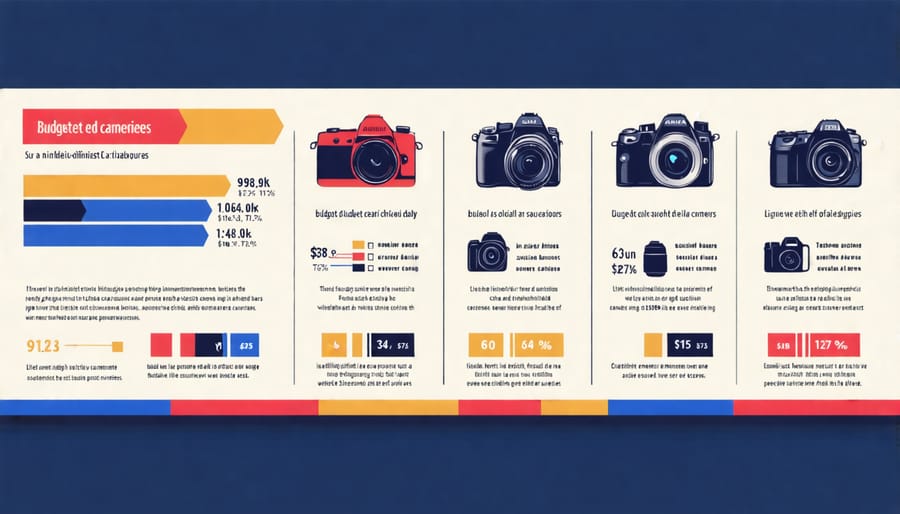
Top Recommendations for Different Budgets
Budget-Friendly Options
Finding a quality digital camera without stretching your budget might seem daunting, but it’s entirely feasible with a look into the right models. For those eager to embark on their photography journey or upgrade their gear, several less-costly cameras deliver impressive performance without compromising on essential features. Consider the Nikon D3500—an excellent choice for beginners, offering user-friendly controls and a robust suite of manual settings to hone your skills. Likewise, Canon’s EOS Rebel T7 provides tremendous value with its impressive image quality and built-in Wi-Fi for seamless sharing.
For enthusiasts keen on portability, the Sony Alpha a6000 stands out with its fast autofocus and compact build, perfect for on-the-go shooting. Finally, if venturing into the world of mirrorless cameras, the Olympus OM-D E-M10 Mark III offers advanced stabilization and intuitive design, making it a top contender for both new and seasoned photographers alike. These cameras prove that you can achieve great results on any budget, emphasizing that quality doesn’t always equate to cost.
Mid-Range Selections
For intermediate users seeking to step up their photography game without breaking the bank, mid-range digital cameras offer an excellent blend of performance and affordability. These cameras are perfect for enthusiasts who are ready to explore more advanced features, such as manual controls and higher quality lenses, which bring your creative visions to life. Imagine capturing the swift elegance of a bird in flight or the vibrant hues of a sunset with clarity and precision—that’s the kind of performance you can expect here.
A popular choice in this category includes mirrorless cameras that boast compact designs but don’t skimp on image quality. With brands like Fujifilm and Sony leading the charge, you’ll find impressive autofocus systems and robust build quality. DSLRs also remain a viable choice, offering optical viewfinders and a vast range of lenses for creative flexibility. Intermediate photographers will appreciate features like burst shooting and 4K video, allowing them to grow their skill set while experimenting with different styles and techniques.
When selecting a mid-range camera, consider how you wish to use it: whether for travel, wildlife, or portrait photography. By finding the right balance between features and cost, these mid-range models can help you hone your skills, bringing your photographic stories to life.
Premium Choices
For those striving to capture their artistic vision with precision, stepping into the realm of premium digital cameras is a game-changer. Models like the Canon EOS-1D X Mark III and the Nikon Z9 are favored by professional photographers for their exceptional image quality and high-speed performance. These cameras deliver stunning resolution, allowing photographers to bring their subjects to life in exquisite detail.
With features like advanced autofocus systems and robust weather sealing, these premium choices are designed to withstand the rigors of demanding shoots—be it a windswept mountain range or the bustling streets of a city. Imagine photographing a high-energy sports event; these cameras ensure you don’t miss a moment with rapid continuous shooting speeds. For those passionate about video, 8K recording capabilities open new creative opportunities, transforming every project into cinema-quality experiences. Balancing innovation and durability, these high-end digital cameras empower photographers to push the boundaries of their craft.
Conclusion
Choosing the right digital camera can greatly enhance your photography skills and ensure that your investment aligns perfectly with your needs and goals. Throughout this guide, we explored various camera types and crucial features, providing you with the insights needed to make an informed decision. The key is to match the camera’s capabilities with your specific photography ambitions, whether you’re capturing the subtle details of nature, the energy of bustling streets, or crafting charming family portraits. Remember, there is no one-size-fits-all solution, but understanding your personal requirements can lead you to the camera that feels like an extension of your creativity. As you navigate through different options, consider what inspires you as a photographer and let that guide your choice. Armed with this knowledge, you’re well on your way to capturing remarkable moments that truly resonate with your artistic vision.



